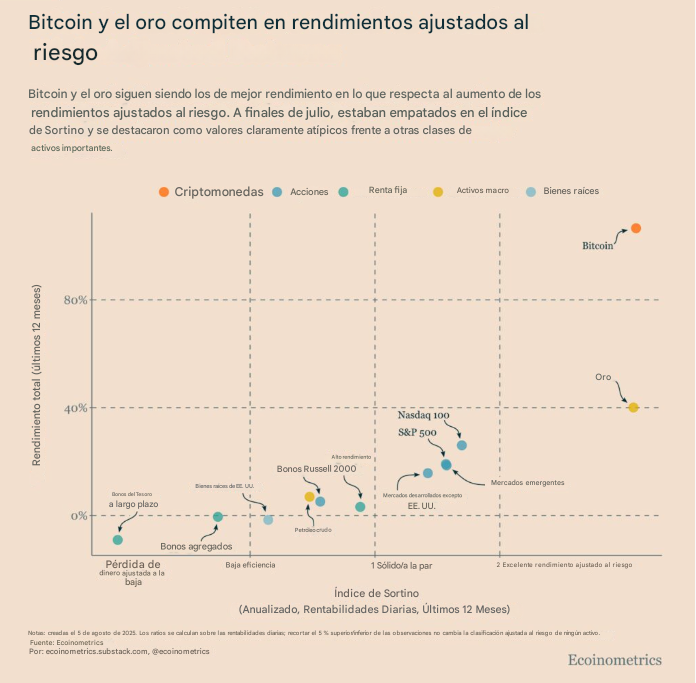Rodolfo Andragnes, founder of the Argentine Bitcoin NGO, made a publication stating that, in the current context, who do not assign at least 20% of their wealth to Bitcoin (BTC) a series of deep changes are being lost sight of.
Besides, Andragnes considers that this percentage should increase the closer it is to transfer that capital to the next generations.
“At this point, who does not have at least 20 % of its generational wealth in Bitcoin, is watching another film … that % should be greater the closer to transfer it,” he said.
His comment was given in response to a analysis of ecoinometrics, which stands out to Bitcoin and gold as The two assets with the best performance in terms of risk -adjusted returns in recent times.
The evaluation indicates that both value reserves lead the ranking based on the Sortino ratio – a metric that measures yields in relation to negative volatility – and are positioned well above the rest of the market.


What does it mean to have high returns adjusted to risk?
When talking about risk -adjusted returns, it is not only considered how much an asset earns, but also how stable and sure that performance is over time. Sortino’s ratio, unlike other indicators such as Sharpe, only takes into account falls or losses, which makes it especially useful for assessing assets such as bitcoin and gold, as investors want to prepare for negative volatility.
It should be noted that the creation of Satoshi Nakamoto and the yellow metal share several characteristics: both are scarce assets, do not depend on the emission of central banks and are usually considered shelters against inflation and economic instability.
However, there are key differences between them. Unlike gold, whose offer is difficult to estimate precisely, Bitcoin has a predictable and transparent monetary policy: Your supply is limited to 21 million units And, every four years, an event called halvingwhich in half reduces the issuance of new currencies.
In addition, Bitcoin is much easier to transfer and store. While moving large amounts of gold implies high logistics costs, BTC can be sent anywhere in the world in just minutes.
Generational investment and long -term vision
For Rodolfo Andragnes, the characteristics of Bitcoin not only make it a good asset to diversify wallets, but also a strategic option to preserve long -term wealth. Hence its reference to “generational wealth”, understood as the capital that is sought to conserve and transfer between generations.
This long -term vision is also shared by Mexican businessman Ricardo Salinas Pliegoone of the most wealthy in the country, who is a firm defender of Bitcoin. As Cryptonotics reported, approximately 70% of its portfolio is composed of BTC, including investments in mining companies and linked funds, while the rest is mainly concentrated in physical gold and mining actions.
Salinas emphasizes that its strategy does not consist of speculating with daily fluctuations, but in protecting against the loss of value of the Fíat currencies and the threats that represent the digital currencies of central banks (CBDC).
For his part, recently the writer and businessman Robert Kiyosaki also warned about the risks of not incorporating Bitcoin into investment strategies, noting that maintaining savings in Fíat coins exposes a constant loss of value due to inflation and excessive emission. In fact, the author of Rich father, poor father He lamented by those who have not yet invested in BTC.


